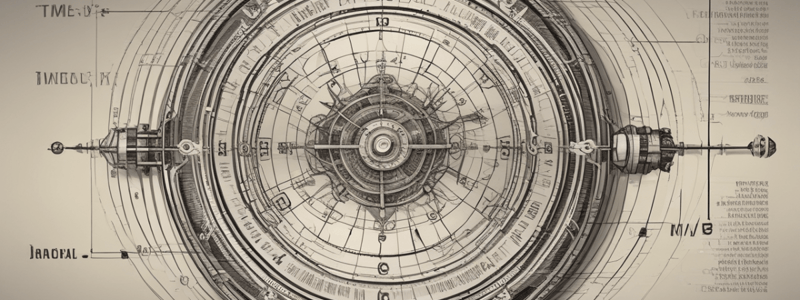Podcast
Questions and Answers
What is the SI unit of time according to the International System of Units?
What is the SI unit of time according to the International System of Units?
- Day
- Hour
- Minute
- Second (correct)
What is the study of time and its measurement called?
What is the study of time and its measurement called?
- Horology (correct)
- Astronomy
- Meteorology
- Geography
What is the base unit of time?
What is the base unit of time?
- Hour
- Year
- Second (correct)
- Minute
How was time measured in ancient societies?
How was time measured in ancient societies?
How many days are in a leap year?
How many days are in a leap year?
What is the purpose of sundials?
What is the purpose of sundials?
What is the relation between seconds and hours?
What is the relation between seconds and hours?
How long does it take for a sapling to show significant growth?
How long does it take for a sapling to show significant growth?
How do you convert a larger unit of time to a smaller unit?
How do you convert a larger unit of time to a smaller unit?
What is the purpose of converting units of time?
What is the purpose of converting units of time?
Flashcards are hidden until you start studying
Study Notes
Units of Time
- Units of time are standards used to measure intervals, and a duration or amount of time is expressed using the most appropriate unit of time.
- The International System of Units (SI) defines the second as the base unit of time.
- There are very small units of time (e.g., seconds) and very large units of time (e.g., years).
Examples of Units of Time
- Blinking: a few seconds
- Brushing teeth: a few minutes
- A flight from Canada to Paris: a few hours
- Symptoms of the flu: a few days
- Significant growth of a sapling: a few weeks
- Pregnancy: many months
History of Time Measurement Units
- Measuring of time started over 30,000 years ago, using the patterns of the moon, shadows of the sun, and the placement of the stars in the sky.
- Sundials were used to determine the time of day based on the shadow formed from the sun.
- As civilization and technology advanced, standard units and clocks made it easier to measure time.
- Time is now measured based on the vibrations of the cesium-133 atom.
Types of Time Measurement Units
- Second: base unit of time, used for very small intervals of time (e.g., blinking, breathing, snapping)
- Minute: larger than second, smaller than hour, used for small intervals of time (e.g., drinking coffee, taking a walk, boiling water)
- Hour: largest unit of time, used for large intervals of time (e.g., baking a cake, studying)
- Day: made up of 24 hours, used for events that take a few days (e.g., hearing back from an interview)
- Week: made up of 7 days, used for events that occur weekly (e.g., using products once they are open)
- Month: made up of 30 or 31 days (February is 28 or 29 days), used for events that occur monthly (e.g., salaries being credited)
- Year: made up of 365 days (366 days in a leap year), used for events that occur annually (e.g., birthdays)
Converting Units of Time
- Conversion of units is necessary to express time in the most appropriate unit.
- Converting units can happen from smaller to larger units or vice versa.
- Examples of conversion:
- 1 minute = 60 seconds
- 1 hour = 60 minutes
- 1 hour = 3600 seconds
- To convert a larger unit to a smaller unit, multiply; to convert a smaller unit to a larger unit, divide.
Examples of Conversion
- Convert 720 seconds to minutes: 720 / 60 = 12 minutes
- Convert 18 minutes to seconds: 18 x 60 = 1080 seconds
- Convert 185 minutes to hours and minutes: 185 / 60 = 3.05 hours, 0.05 x 60 = 3 minutes
- Convert 20 days to hours: 20 x 24 = 480 hours
- Convert 7893 seconds to hours, minutes, and seconds: 7893 / 3600 = 2.1925 hours, 0.1925 x 60 = 11.55 minutes, 0.55 x 60 = 33 seconds
Studying That Suits You
Use AI to generate personalized quizzes and flashcards to suit your learning preferences.




